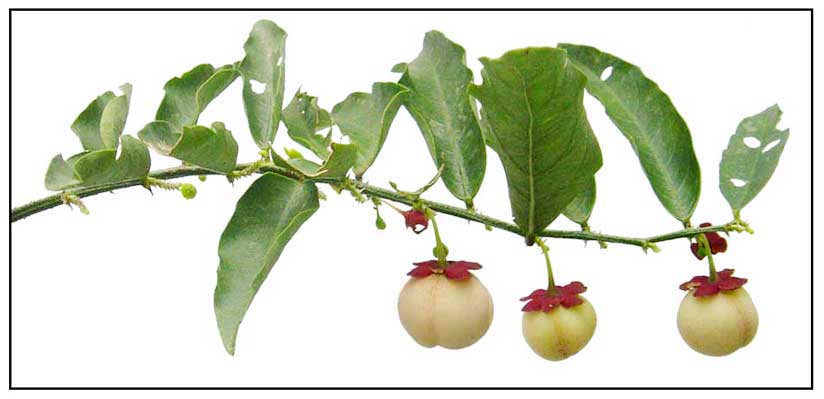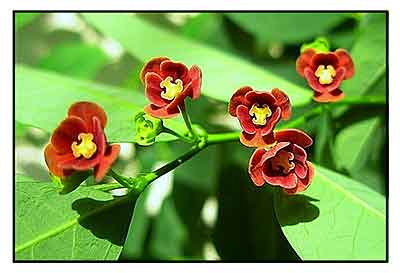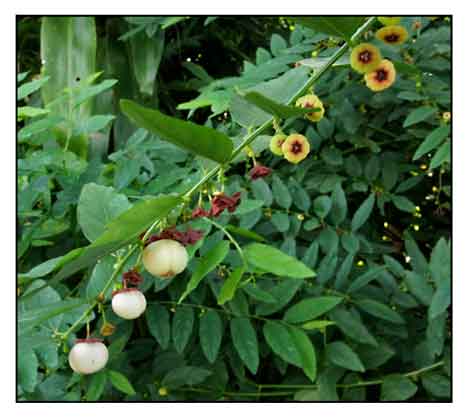
Gen info
- Breynia is a plant genus in the family Phyllanthaceae.
- Etymology: The genus Breynia is named after the 17th century Polish botanist Jacob Breyne and his son Johann Philipp Breyne. The species epithet androgyna is Latin referring to the presence of male and female flowers on the same plant.
 Botany Botany
Binahian is an erect, perennial shrub growing to a height of 2.5 to 3 meters. Leaves are dark green, 2 - 6 centimeters long, 1.5 to 3 centimeters wide, usually with faint, grayish speckled markings on the upperside. Flowers are red and small, developing into round to angular white or purple fruit capsules measuring about 1.5 centimeter diameter.
Distribution
- Native to the Philippines.
-
Also native to Assam, Bangladesh, Borneo, Cambodia, China, Hainan, Himalaya, India, Jawa, Laos, Lesser Sunda Is., Malaya, Maluku, Myanmar, New Guinea, Sri Lanka, Sulawesi, Sumatera, Thailand, Vietnam. (9)
- A scrambliing shrub or tree, growing primarily in the wet tropical biome.
- In some SE Asian countries, cultivated on a commercial scale.
 Constituents Constituents
- Leaves are an excellent source of provitamin A, vitamins B and C, proteins and mineral.
- Protein content is higher than most other leafy vegetables; the mature leaves having more nutrients than the young leaves.
- Contains a considerable amount of alkaloid "papaverine" (580 mg of papaverine per 100 g of fresh leaf).
- Study of aerial parts yielded a lignan glycoside, (−)-isolariciresinol 3α-O-β-apiofuranosyl-(1→2)-O-β-glucopyranoside, and a megastigmane glucoside, sauroposide, were isolated from the aerial part of Sauropus androgynus, together with (+)-isolariciresinol 3α-O-β-glucopyranoside, (−)-isolariciresinol 3α-O-β-glucopyranoside, (+)-syringaresinol di-O-β-glucopyranoside, guanosine and corchoionoside C. (3)
- Study yielded a lignan glycoside and a megastimane glucoside, sauroposide from the aerial parts.
- Nutrition analysis of 100 g. of fresh leaves yielded: protein 7.4 g, fat 1.1 g, fiber 1.8 g, moisture 69.9 g, carotene 5600 µg, riboflavin 0.21 mg, thiamine 0.50 mg, calcium 711 mg, vitamin C 244 mg, phosphorus 543 mg, iron 8.8 mg. (11)
- Constituent analysis of leaves yielded carbohydrates+, reducing sugar+, protein, sterols+, resins+, tannins++, saponins++, alkaloids++, flavonoids++, terpenoids+, glycosides++,++ phenols++, cardiac glycosides+. (13)
- GC-MS analysis of leaves
yielded 9 compounds. Major compounds were 2(1H) Naphthalenone, 3,5,6,7,8,8a-hexahydro-4,8a-dimethyl-6-(1- methylethenyl) and Azulene. Other compounds were 1,14-tetradecanediol, 1-octadecyne, 1-hexadecyne, decanoic acid (ethyl ester), phytol, hexadecahydro-pyrene, and squalene. (13)
- Study of BuOH-soluble EtOH extract from aerial part of Sauropus androgynus characterized six bioactive constituents including three nucleotides--adenosine (1), 5′‐deoxy‐5′‐methylsulphinyl‐adenosine (2), and uridine (3), two flavonol dioside — 3‐O‐β‐D‐glucosyl‐7‐O‐α‐L‐rhamnosyl‐kaempferol (4), 3‐O‐β‐D‐glucosyl‐(1→6)‐β‐D‐glucosyl‐kaempferol (5), and one rare flavonol trioside — 3‐O‐β‐D‐glucosyl‐(1→6)‐β‐D‐glucosyl‐7‐O‐α‐L‐rhamnosyl‐kaempferol (6). (26)
Properties
- Studies have suggested antioxidant, anti-obesity, apoptotic, antimicrobial, wound healing, anti-diabetic, anti-anemic, anti-stress, toxic properties.
Propagation
- Propagated by stem cuttings.
- Harvested 4 months after planting.
- Tender young leaves harvested from the top 15 centimeters of the stem tips.
- A fast growing vegetable with abundant fruiting.
Parts used
Roots, leaves.
Uses
Edibility / Culinary
- Young shoots, leaves, flowers and fruits, eaten raw or cooked, with a pleasant , slightly nutty taste, with a flavor of fresh garden peas and the texture of asparagus.
- Leaves and stem tips used as salad or steamed, added to stir-fries, egg dishes and casseroles.
- Young shoots fried with chili pepper and dried shrimp.
- Fruits are candied.
- Green dye squeezed out of the leaves used as food coloring for pastries, rice and preserves.
Folkloric
- Decoction of roots said to relieve urinary disorders; also, used for fever.
- Leaves used as vegetable by nursing mothers to stimulate breast milk production.
- Leaves used after childbirth to help the womb recover.
- In Taiwan, herb used as slimming agent to combat obesity. (11) Raw juice of young sticks and leaves widely used as natural food for body weight reduction and vision protection. (8)
- In Malaysia and Indonesia, believed to increase lactation in women. in Malaysia, also used to relieve fever, treat urinary problems. (11) Ingestion of the fresh leaves by the elderly has been reported to cause drowsiness and constipation.
- In India, leaves used as antidiabetic and to improve vision. (11)
- In Indonesia, used to increase breast milk and treat ulcers and fever. Leaves used for constipation. Also used to treat fever and cough.
- In Indonesia, the flowers, leaves, and fruits has been consumed and used traditionally since ancient times by the Javanese and Sundanese ethnic groups as alternative medicine, Jamu, a concoction native to Java Island formulated to improve circulation of blocked breast milk of breastfeeding mothers. (10)
Others
- Fodder: In India, leaves used as fodder for cattle and poultry feed. Leaves used as supplement feed for pigs.
- Ornamental: In East Java, plant used as bride's forehead ornament. Rarely used now, leaves were crushed, squeezed, and the water used to color the bride's forehead as bridal makeup. (24)
Toxicity
• Excessive consumption of leaf extracts: Excessive consumption of leaf extracts may be toxic. Leaves contain considerable amount of the alkaloid papaverine (580 mg/100 gm fresh leaves). Excessive consumption of the leaf causes dizziness, drowsiness, constipation. Papaverine in uncooked sauropus affects vasodilation, may cause bronchiolitis obliterans, a progressive respiratory distress disease. the harmful effect is due to consumption of large quantities of uncooked leaves (4.5 kg) and drinking raw juice rather than stir-fried or boiled leaves.
• Toxic Effects: First study on toxic effects was done by Bender and Ismail, reporting that the plant caused drowsiness and constipation, demonstrating that fresh leaves yielded 580 mg of alkaloid "papaverine" [er 100 g, an excessive amount considering only 200 mg of papaverine is required as an antispasmodic drug. (11)
• Papaverine: Report of 44 individuals suffering from temporary insomnia, poor appetite followed by progressive difficulty breathing four weeks after ingestion of S androgynous of Sabah vegetable. Open lung biopsy disclosed bronchiolitis obliterans organizing pneumonia. Although papaverine was previously identified in the vegetable, it was deemed unlikely to be responsible for the whole range of toxicity seen.
• Bronchiolitis obliterans: Bronchiolitis obliterans is an uncommon pulmonary disease characterized by inflammatory changes of the membranous and respiratory bronchioles. Histopathology varies from subtle cellular infiltrates surrounding the small airways to extensive infiltrates with fibrosis and smooth muscle hyperplasia to complete obliteration of the bronchial lumens. (2) (6) (7)
• Lung Transplantation: In Taiwan, over 30 patients developed progressive respiratory failure after consuming the extract from raw SA leaves as a means of losing weight. Despite cessation of intake, severe obstructive ventilatory defect progressed. Five patients underwent lung transplantation. Authors believe lung transplantation to be the only effective modality for patients with end-stage SABO syndrome. (5)
• Acute Lung Toxicity of Juice and Soup of Katuk Leaves as Breast Milk Booster / Dose Dependent: Katuk as traditional medicine to supplement breast milk production has been widely used by people of Indonesia. Study conducted in vivo toxicity tests on katuk leaves originated from East Java, and given in the form of vegetable juice and stew orally to female Wistar rats in various doses (500, 1000, 3000, and 5000 mg/kg). The administration of soup and juice did not cause changes in physical condition of the rats. The leaf juice caused significant differences in macroscopic measures of lung volume as well as microscopic finding of significant variation in the bronchial lumen ratio between leaf juice treated group 5000 mg/kg and negative controls. The leaf soup caused significant variations in macroscopic measures of lung volume and microscopic size of bronchial lumen. Results suggest that toxic necrosis is dose-dependent. (35)
Studies
• Bronchiolitis Obliterans: Study establishes the association between consumption of S. androgynus and the BO syndrome. The cases in the report ingested S. androgynous more frequently (more than twice a week) and in large amounts (average per week, 814± 417 g). Patients in the report also consumed uncooked juice, rather the the traditional boiled and stir-fried form of preparation. (2)
• Antioxidant: Study demonstrated the antioxidant capacity and nutritive values of Pak-Wanban.
• Immunohistochemical Analysis: Study suggests a possibility is indicated that a disproportion of Matrix metalloproteinases/Tissue inhibitor of metallo-proteinase occurred in the bronchiole local field, and might be involved in the disease state formation of bronchiolitis obliterans. (7)
• Necrosis and Apoptosis Involved in Toxicity: Study results indicate that necrosis and apoptosis are involved in the toxic effect of Sauropus androgynus in NIH3T3 fibroblasts. More evidence is needed to clarify if necrosis and apoptosis are also related to the pathogenesis of SA-associated obliterative bronchiolitis. (8)
• Anti-Obesity / GGK: The anti-obesity effect has been confirmed in previous studies. However, the increase in cases of brochiolitis obliterans in Taiwan has raised caution and concerns on its anti-obesity use. This study focused on the isolated compound GGK (3-O-β-D-glucosyl-(1-6)-β-D-glucosyl-kaempferol) in combination with EtOAc and n-BuOH fractions for body weight in Wistar male rats. Results showed a reduction in food intake and body weight in rats. Results conclude that GGK has potential as anti-obesity agent without the side effects observed when consuming the entire plant. (11)
• Benefits and Toxicity of Fresh Leaves: The antioxidative components of SA leaves have shown vast health benefit to humans, from test tubes to in vivo studies. However, extract precaution is advised for minimizing the adverse health effect of consumption of fresh leaves because of antinutrient and heavy metals content. (see above) (12)
• Antioxidant / Antimicrobial / Stems: Study evaluated the antimicrobial, antioxidant, and anticancer properties of SA stem extract. Results showed the stem extract to have high antimicrobial activity, moderate antioxidant activity (inhibition concentration 50% with IC50 of 8 ppt DPPH), with no anticancer activity. (see constituents above) (14)
• Wound Healing: Study evaluated the wound healing effect of 5% S. androgynus on excision and incision wound models on Wistar rats. Results showed the extract significantly promoted wound healing in both models, significantly augmenting wound contraction (p<0.001), significantly re-epithelization (p<0.0001) and increase in wound breaking strength (p<0.001). (15)
• Anti-Diabetic / α-Glucosidase Inhibition / Leaves: Study evaluated an alcoholic extract of leaves of S. androgynus for antidiabetic effect in alloxan induced diabetic rats. On drug receptor interaction study, the isolated compound, a bound flavonoid which binds with α-glucosidase, showed excellent hydrogen bond and hydrophobic interactions. Results suggested the isolated compound is a potent α-glucosidase inhibitor with good antidiabetic potential. (16)
• Treatment of Recurrent Aphthous Stomatitis / Leaves / Clinical Trial: Randomized, placebo-controlled study evaluated the efficacy of Sauropus androgynus leaves in capsule and ointment forms in patients with recurrent aphthous stomatitis (RAS). S. androgynus showed advantages over steroids and is safe in all patients including infants and pregnant women. Topical application suggested some protective or barrier function for the ointment and is suggested as the first choice of treatment. (17)
• Anti-Anemia Effect / Chlorophyll / Leaves: Study evaluated the effect of chlorophyll isolated from katuk leaves on levels of Hb, malondialdehyde (MDA), ferritin, and schistocytes percentage in female mice induced NaNO2. Results showed an increase in ferritin levels. The antioxidant activity of chlorophyll from katuk leaves decreased schistocytes percentage and MDA levels. The increase of Hb and ferritin levels indicate a potential for treatment of hemolytic anemia. (18)
• Anti-Stress / Toxicity Study / Leaves: Study investigated the anti-stress activity of a hydroalcoholic extract of Sauropus androgynus leaves against experimentally induced stress in rats using forced swimming endurance test and chronic cold restraint stress test. Acute toxicity study of the leaf extract to be safe at a dose of 2000 mg/kbw. Parameters of cholesterol, triglycerides and corticosterone were estimated to determine the anti-stress activity. Results suggest significant dose-dependent anti-stress activity. (19)
• Segmental Small Bronchi Necrosis after Prolonged Intakes of S. androgynus: Since 1994 an endemic of COPD has developed in Taiwan after prevalent use of body-weight reducing vegetable, S. androgynus. Lung biopsy specimens revealed bronchiolitis obliterans. Excised lungs revealed focal fibromuscular sclerosis and obliteration of bronchial arteries. Pathologic changes were most consistent with segmental ischemic necrosis of the bronchi. (20)
• Antibacterial / Leaves: Study evaluated the antibacterial activities of various extracts of Sauropus androgynus leaves against Gram positive and Gram negative bacterial strains. A methanol extract showed significant antibacterial activity against all six bacterial test strains. The antibacterial activity of the leaf extract was attributed to the presence of multivitamins and peptides, glycosides, alkaloids, saponins, terpenoids, flavonoids, etc. (21)
•
Expression of Prolactin and Oxytocin Genes in Lactating Mice Supplemented with Leaf Extracts: S. androgynus is believed to increase breast milk production during lactation and is traditionally consumed by Indonesians. The expression of oxytocin gene in the lactating mice supplemented with SA leaf extracts increased significantly. The prolactin gene expression level in the mice group supplemented with leaf extracts increased significantly compared to control. The increased gene expression could be related to papaverine content in mature leaves that relaxed smooth muscles and dilated blood vessels. (22)
• Antioxidant / Anti-Inflammatory / Leaves: Study evaluated the antioxidant (DPPH, reducing power, hydroxyl radical scavenging, superoxide radical scavenging) and anti-inflammatory (inhibition of protein denaturation, membrane stabilization models) properties of Sauropus androgynus leaf dialysed protein extract. Results illustrated antioxidant and anti-inflammatory activities. Antioxidant property is attributed to polyphenols and flavonoids. Results suggest a potential for cosmetic and therapeutic applications. (23)
• Cytotoxicity on Human Mesenchymal Stem Cells: Study evaluated the in vitro toxic effects of S. androgynus on human mesenchymal stem cell culture derived from bone marrow (hMSCs-BM). The methanol extract from East Java was less cytotoxic to hMSCs-BM with IC50 of 2450 mgL, but could inhibit cell viability via the apoptosis pathway. Further studies to investigate the metabolites in S. androgynus that are highly correlated with its toxic effects. (25)
• Promotion of IL-2 Cytokine Production of CD4-T Cells in Pregnant Mice with Typhoid Fever: Production of IL-2 by CD4 T cells is shown to be suppressed in pregnant women infected by bacteria such as Salmonella typhi. Study evaluated the efficacy of Sauropus androgynus and Elephantopus scaber as herbal formulation to promote lymphoid proliferation and CC4 cytokine productions. Study showed typhoid fever decreased the amount of CD4 T cells and increased the amount of B cells. The formulation of E/ scaber and S. androgynus ameliorated the condition by increasing IL-2, IFN-y, and CD4 T cells and decreased both IL-4 cytokine production and the amount of B cells. (27)
• Effect on Level of B220 Cells of Lymph Node in Pregnant Typhoid BALB/c Mice / Herbal Combination: Elephantopus scaber and Sauropus androgynus are herbal remedies that contain flavonoids as immunomodulatory agents. Study evaluated the changes in the relative number of B cells in lymph node tissue of pregnant typhoid mice. Results showed the combination can increase the number of B220 cells (p<0.05) on pregnant mice typhoid model. (28)
• Antioxidant / Radical Scavenging / Phytoconstituents / Leave and Seeds: Study evaluated Sauropus androgynous as source of antioxidants. GC-MS of leaves yielded 20 active phytoconstituents with the vitamin C as major component. The seeds yielded 10 components with fatty acids as major components. The leaf and seed extract showed significant DPPH scavenging activity (IC50 of 49.62 ± 2.652 and 52.47 ± 2.21 µg/mL) compared with ascorbic acid standard with IC50 of 48.82 ± 1.80. (29)
• Anti-Alopecia / Leaves: Study evaluated the anti-alopecia characteristics of ethanol extract and various fractions of leaves from katuk. Minoxidil 2% was used as positive control. Results showed the leaf extract exhibited significant hair growth activity at concentrations of 10%, 15^, 20%, and 25%, The water fraction showed positive hair growth activity compared to n-hexane, ethyl acetate, and positive control. Results suggest potential as anti-alopecia treatment. (30)
• Anti-Inflammatory / Analgesic / Leaves: Study evaluated aqueous and ethanolic extract of leaves of S. angrogynus in Wistar rats for analgesic activity using Hot Plate Test and anti-inflammatory activity using carrageenan-induced rat paw edema. The ethanolic extract showed more significant anti-inflammatory effect than the aqueous extract. Significant reduction in paw edema and significant increased reaction time were seen at dosage of 400 mg/kbw. (31)
• Effect on Egg Production of Layer Chickens: Study evaluated the effect of S. androgynus extract supplementation on egg production and lipid metabolism in layer chickens. SAE supplementation significantly reduced abdominal fat, gizzard surround fat, liver fat (p<0.05) serum triglyceride, total cholesterol, VLDL+LDL-c (p<0.01), atherogenic index (p<0.05), egg cholesterol, triglyceride (p<0.05) with no effect on mesenteric fat, sartorial fat and fatty liver. Results showed supplementation of hot water extracted SAE or ethanol extract SAE improved egg production and feed conversion efficiency, and reduced egg cholesterol. (32)
• Effect on Milk Production and Breastfeeding: Study suggests S. androgynous orally can increase the quantity of milk production. The effect may be attributed to alkaloids and sterols from katuk leaves which can increase the metabolism of galactose. (33)
• Effect on Pulmonary Functions 15 Years After Sauropus androgynus-Related Obstructive Lung Disease: Study evaluated the clinical manifestations and pulmonary changes 15 years after an acute episode of Sauropus androgynus-related obstructive lung disease. Of 29 of 49 patients (four died, one was ventilator-dependent) who could be contacted, 16 agreed to pulmonary function and questionnaire evaluation. The FEV1 in these patients only declined 1.6 ± 21.6 mL/year over a 15-year period. The severity of the dyspnea and health-related quality of life were better than age- and FEV1. Further study with a larger sample size is suggested to confirm the findings. (34)
• Xanthine Oxidase Inhibitory Activity / Anti-gout / Leaves: Study evaluated the xanthine oxidase (XO) inhibitory activity of three plants viz. Sauropus androgynus, Aerva lanata and Benincasa hispida to demonstrate its usefulness and beneficial effects in gout. All three showed significant XO inhibitory activity with IC50s of 80.12, 62.53, and67.97 µg/mL, respectively. The XO inhibitory activity may be useful in preventing or slowing down the progress of gout. (36)
• Anticonvulsant / Leaves: Study evaluated the anticonvulsant activity of hydroalcoholic extract of Sauropus androgynus leaves against PTZ- and picrotoxin-induced convulsions in mice. Both 200 and 499 ng/kbw doses p.o. showed significant dose-dependent reduction in mortality rate and increased recovery in rats. There was decrease in duration of convulsion and increase time for onset of convulsion. Maximum protection was observed at 400 mg/kg dose. (37)
• Effect of Pre-Extraction Preparation on Antioxidant Compounds / Leaves: Study evaluated the effect of pre-extraction preparation and procedures (sample form, drying process, particle size) on total phenolic and flavonoid contents. Results showed pre-extraction preparation influenced antioxidant components in leaves. Fresh leaves contained higher phenolics and flavonoids (33.66 mg GAE/g and 11.61 mg QE/gm, respectively) than dried leaves. Particle size, powdered dried leaves have higher phenolics and flavonoids than ground dried leaves. Oven-drying showed highest phenolic content, while air-drying showed highest flavonoid content. All extracts showed IC50s against DPPH radicals around 85.71-93.91 ppm. Pre-extraction in optimum conditions makes for more efficient and effective target compounds with antioxidant activities. (38)
• Antibacterial / Anthelmintic / Leaves: Study evaluated ethanolic leaf extracts of S. androgynus. for in-vitro antibacterial and anthelmintic activity against Indian earthworm Pheretima posthuma. of ethanolic leaf extracts of S. androgynus. Both gram-positive and gram-negative test bacteria (B. subtilis, S. aureus, P. aeruginosa, E. coli) were sensitive to the extract. Results showed vermifuge and vermicidal activity. Gentamicin and albendazole were used as controls. (39)
• Hypoglycemic / Antianemia Effects / Chlorophyll / Leaves: Study evaluated the hypoglycemic effects of leaf extract in STZ-induced diabetic rats and antianemia in iron-deficient anemic rats. Extract and commercial chlorophyll treatment for 14 days demonstrated hypoglycemic effects and exhibited significant restorative effects by returning the levels of hemoglobin, serum iron, and serum ferritin. The safety dose should be considered to prevent toxicity. (40)
• Anti-Peptic Ulcer / Leaves: Study evaluated the anti-peptic ulcer effect of ethanolic extract of leaves in an aspirin-induced peptic ulcer model in rats (Rattus norvegicus). Results showed potential as alternative peptic ulcer therapy suggested by decrease expression of TNF-α and repair of duodenal histopatholgy involving structure of epithelial duodenum, decrease of inflammatory cell and vascular vasodilatation. The effective dose of the ethanolic extract was 48.6 mg/200 g BW. (41)
• Antimalarial / Cytotoxic / Leaves: Study evaluated the in vitro antimalarial and cytotoxic activities of n-hexane, chloroform, and 96% ethanol extract of S. androgynus leaves. Antimalarial activity used Plasmodium falciparum 3D7 strain (chloroquin sensitive). Cytotoxicity assay used Huh7it cells with tetrazolium based colorimetric method. The chloroform, n-hexane, and 96% ethanol extracts showed antimalarial activity with IC50s of 0.85, 1.23, and1.88 µg/mL, respectively. Cytotoxicity results were 136.00, 766.56 and 896.07 µg/mL, respectively. Results suggest the chloroform extract of leaves has potential as antimalarial agent. (42)
• Anti-Inflammatory / Patch Formulation of Leaves: Study evaluated the anti-inflammatory effect of a patch formulation of leaf extract of S. androgynus. A patch of leaf extract of S. androgynus dose of 400 mg/kbw showed percentage inflammation inhibition range between 66 to 100%, which was comparable to diclofenac sodium patch. (43)
• Effect of Storage, Preparation and Heat Treatment on Vitamins and Minerals: Study evaluated the change of water-soluble vitamins and minerals in the vegetable plant when stored in polythene bags at temperature of 6.2±2.89° and moisture 49±13.23% and thermal processing. Throughout storage period, HPLC revealed that except for vitamin B3, almost all water-soluble vitamins of S. androgynous tend to lose around 50% of their weight after 8 days in the refrigerator. After 2 days of storage, Vitamin B3 increased substantially (123.39 mg/100g DW vs 203.75 mg/100g DW), then decreased slightly after 2 days. Change in minerals occurred over 8 days of storage. All analyzed vitamins and minerals decreased after leaves were boiled in water for 15 mins at 90-100°C with two-way pretreatments (rub and non-rub) of leaves. (44)
Availability
Wild-crafted.
Dried leaves, seeds in the cybermarket.
|

![]()






